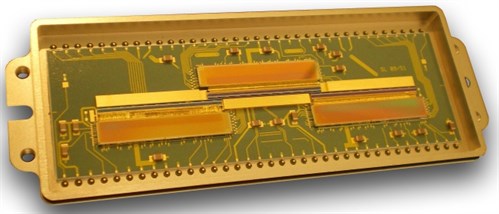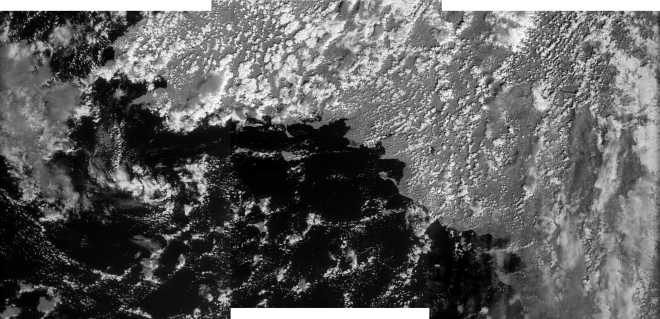May 23, 2013
Three of Xenics’ new Xlin-1.7-3000 SWIR InGaAs detectors are aboard the ESA satellite Proba-V to map vegetation patterns across the face of the earth. This data can be used for alerting authorities to crop failures or monitoring the spread of deserts and deforestation. The first images were captured over Western France on May 15, 2013.
Proba-V got successfully launched by the new VEGA launcher from the Kourou space center on May 7th at 4am CET, after a 24 hour delay due to the local weather conditions. After starting up the satellite and stabilizing its position and orientation, the Vegetation instrument with the VNIR and SWIR imagers could be switched on for the first time on May 15th , well ahead of schedule. The extensive detector test and qualification program ensured the durability against the harsh launching conditions (shock, vibrations, temperature and pressure variations) and all systems turned out to be fully functional.
The image in attachment (courtesy ESA), is the first raw SWIR image transmitted by the Proba-V satellite to the ground station. It shows excellent central on-ground resolution of 100 meters, with a swath of approximately 400 kilometers. Having such high-quality images ahead of schedule without calibration correction, underlines the high intrinsic performance of the InGaAs sensor, the ROIC and the corresponding read-out electronics, all designed and manufactured by Xenics. The stitching of the individual images of three mechanically butted InGaAs arrays results in the typical shape of the image with an upward offset of the central 1024 pixels. Proba-V is equipped with three such detectors, expanding the total swath to 2200 km (divided over approximately 9000 pixels) with a reduced on-ground resolution of the outer sensors. With the support of Xenics, Proba-V is set to provide the world with valuable daily updates of the global vegetation status. 
XLIN-1.7-3000
On May 7, three of Xenics' new Xlin-1.7-3000 SWIR InGaAs detectors has been launched aboard the ESA satellite Proba-V to map crop and vegetation patterns across the face of the earth. Besides delivering highest resolution, the new line-scan detector offers high line rates and low noise.
Uncooled SWIR InGaAs Detector
The Xlin-1.7-3000, is a line-scan detector in InGaAs technology that offers over 3,000 pixels of resolution. This is the best specification of any such device on the market. With its high sensitivity in the SWIR range (0.9 to 1.7 μm) Xlin-1.7-3000 is perfectly suited for the Proba-V (vegetation) satellite mission orbiting at an altitude of 880 km to reveal detailed long-term information on the changing crop and vegetation patterns of the planet and other vital parameters for preserving the biosphere.
Perfectly Suited for Space
Xenics' new Xlin-1.7-3000 line-scan detector is qualified for space missions with 10 krad of ionizing radiation while maintaining its specified performance. A full qualification campaign as prescribed by ESA was carried out, covering harsh environmental, radiation and life test conditions. Three of the new detectors are currently mounted on the Proba-V satellite, ready for launch with the new ESA VEGA launcher from Kourou, French Guyana. Right after the launch, the detectors will start delivering valuable earth environmental information in the SWIR range over a swath of 2,200 km with a center resolution of just 100 m.
The Xlin-1.7-3000 consists of three individual InGaAs sub-arrays of 1,024 square pixels (25 x 25 μm) each. They are mechanically butted on a gold-coated boat and mounted on an alumina substrate, together with three individual readout-ICs (ROIC). The overlap of 20 pixels enables perfect stitching of three individual images to a continuous line of 3,020 pixels over a length of 75.5 mm. The detector is assembled in a custom hermetically sealed 72-pin package with anti-reflective coated window. It is optionally also available in an open package.
Highest Sensitivity and Flexibility
With a fill factor of 100 percent, high quantum efficiency of 75 percent and adjustable sensitivity the uncooled InGaAs detector operates at very low illumination levels. The three individual readout-ICs are manufactured in a 0.35-μm CMOS technology and CTIA topology, which results in a high radiation tolerance for space applications. They allow a maximum pixel rate of 12.5 MHz, which yields a minimum line time of 100 μs, or an output frequency of up to 10 kHz.
The ROICs are designed for maximum flexibility. Thus, once on board the Proba-V mission many of their operational parameters can be controlled in real time to adapt the detectors' characteristics to specific observation conditions and get the best value in terms of line period and integration times (1 μs to 1 sec). Variable gain setting enables the operator to set pixel well depth, which results in a wide span of sensitivity values beginning at just 60 ke- (dynamic range 60:1), to a very high dynamic range of 3,200:1 (pixel well depth 10 Me-). With these features the Proba-V mission can be adapted to various conditions in terms of illumination (night/day), objects of interest (ice/desert/vegetation/water) and global or detailed imaging.
About Xenics
Xenics is a pioneer of path-breaking infrared technology with a proven track record of more than ten years. Xenics designs and markets infrared imagers, cores and cameras of best-in-class image quality to support innovative R&D, industrial automation, machine vision, process control and high-end security applications. The company offers a complete portfolio of line-scan and 2-D area-scan products for the VisNIR, SWIR, MWIR and LWIR ranges. A vertically integrated manufacturer with advanced production facilities and in-house know-how on detector, systems and software development, Xenics delivers state-of-the-art imaging solutions as well as specifically targeted and optimized custom designs. Due to its Western European location and a worldwide sales and service network, Xenics is able to support its customers with simplified export procedures.













